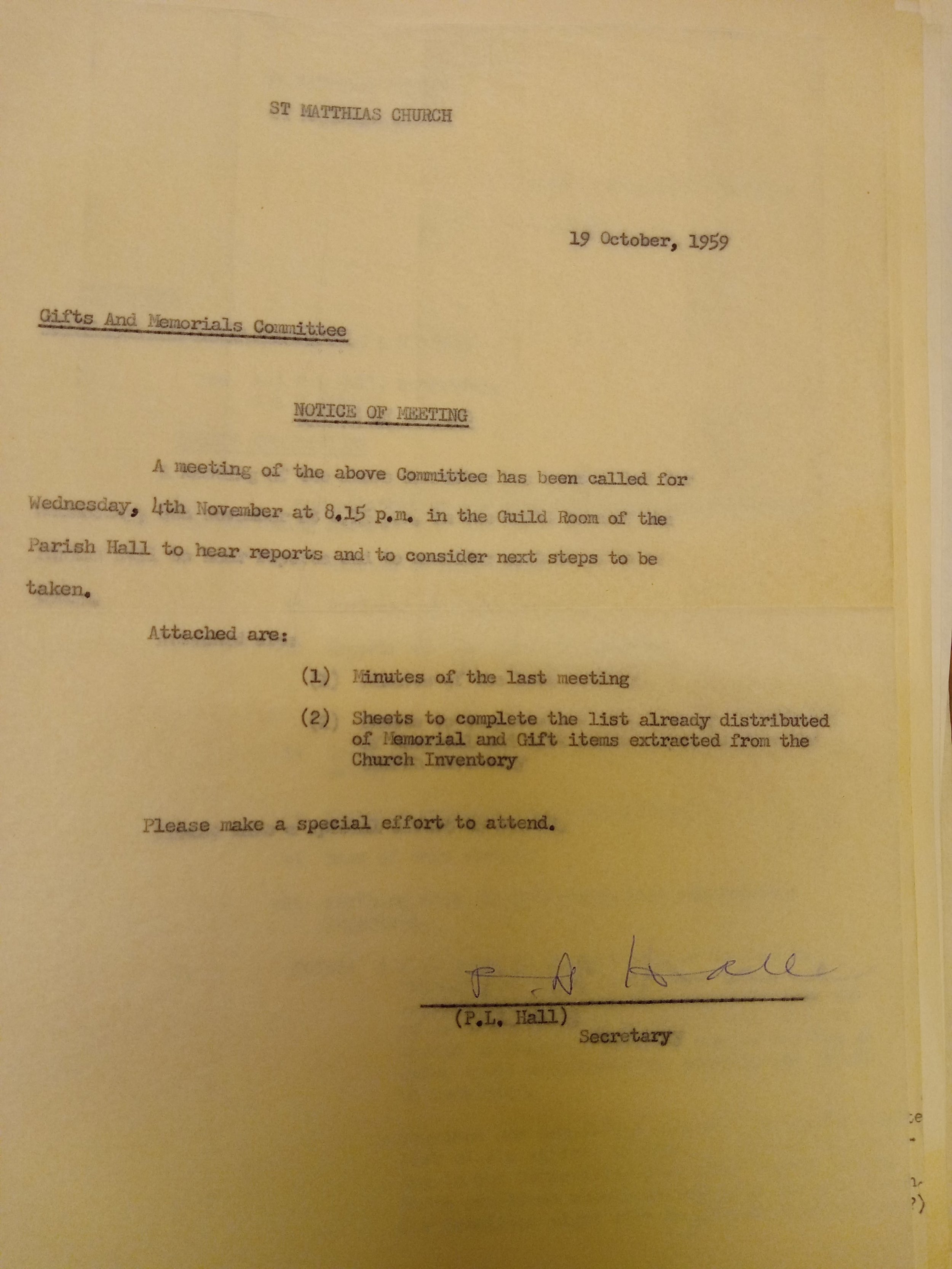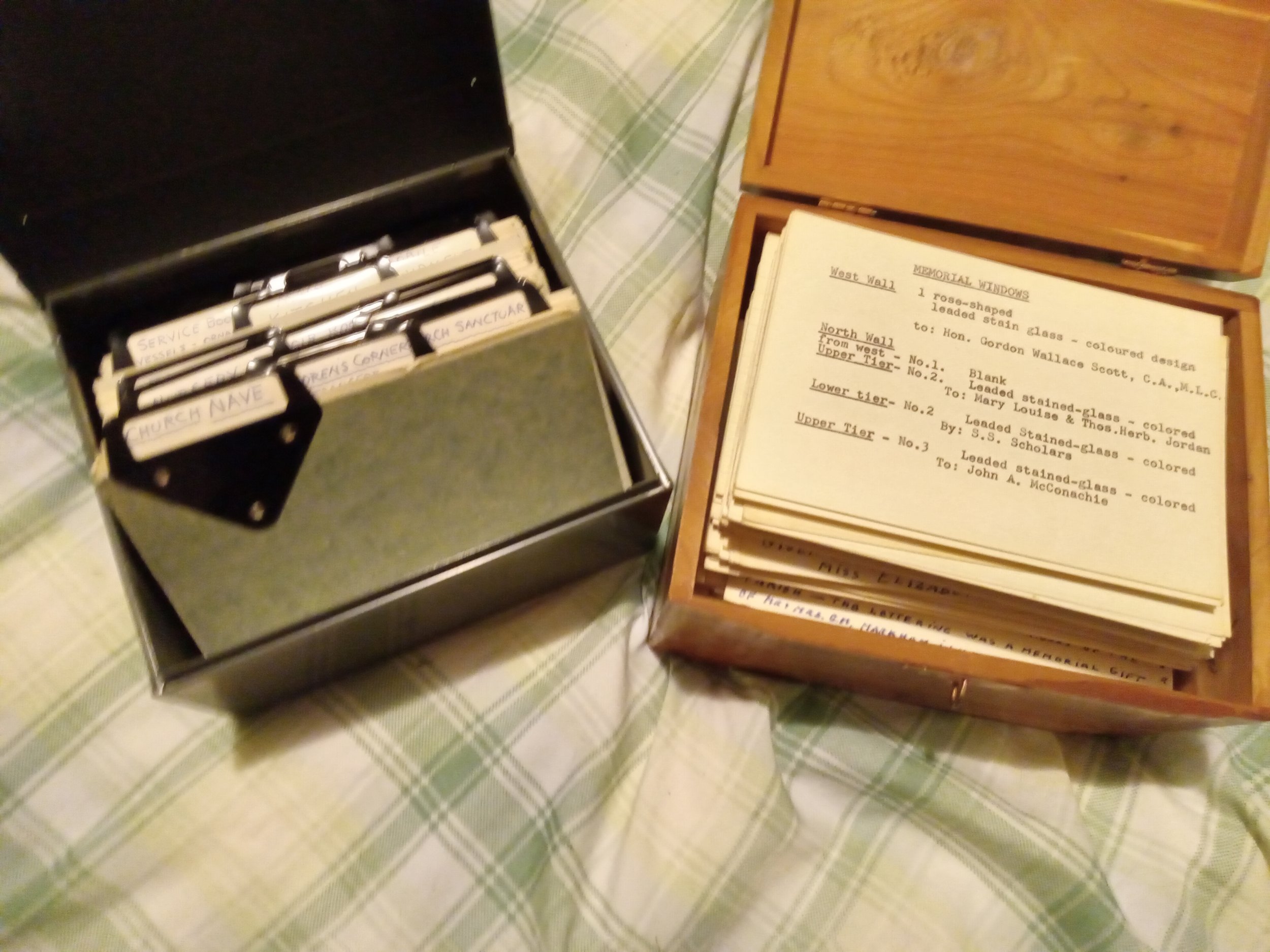June 2nd: A Tale of Many Inventories
St. Matthias’ was officially founded as a mission of St. George’s, Place du Canada, in 1873, which means our community is 150 this year! For the next 12 months, we’ll be diving into the archives to shine the spotlight on particularly interesting parts of our history.
The 1965 card-catalogue inventory, in two parts.
If you were reading a St. Matthias’ parish email in the spring or summer of 2022, you may have encountered a plaintive plea from your wardens on the subject of updating the inventory. “We want you,” you were to imagine Heather Barwick or Jessica Stilwell saying, “to help us catalogue everything in the church that isn’t bolted down!” In the end, the project was not all that onerous, but it also gave us an opportunity to look back at the various ways in which St. Matthias’ has tracked its material goods, to satisfy our insurance agency but also as a way of remembering.
In 1933, a beautiful hand began to fill a little book with precise, even strokes of ink, recording the “Furniture, Immovable & Moveable Effects, etc.” of St. Matthias’ Church. From the oak pews along the centre aisle to the 18 purificators and 25 copies each of sheet music for 130 anthems, no stone was left unturned, although in most cases the provenance of the recorded items was omitted. This inventory was focused, and its focus was the money.
The 1933 inventory was supplemented by typewritten pages in 1939, directed to one Mr. W. O’H Percey. Percey had been a warden from 1931-1933, and St. Matthias’ has a long history of past wardens taking on administrative roles; it is possible that he was charged with the inventory’s upkeep. The inventory was so important in these years that it warranted a mention in the Wardens’ Report to Vestry 1936; typically, both before and after this point, wardens wrote principally about finances. The 1939 update is even more sparse than the 1933 notebook; in many cases, it does not even give the dollar amount.
By 1947, the keeping of the inventory had been passed over to a Miss Edith Walkley, President of the Chancel Guild since at least 1935. She was informed of donations and purchases as they occurred, and updated the inventory regularly at least until the late 1950s – or so this letter would have us believe. The 1939 updates are the last parish-kept inventory that we have until 1965. These gaps in our archives are always tantalising. We can imagine so many possible reasons for an inventory we know was being kept to have simply vanished – the small fire in 1972 whose ashes still colour some of our older documents, the very real possibility that Miss Walkley kept her book at home rather than in the church, the mold that required us to throw out some documents in the early 2000s, the chaos caused by the outbreak of WWII and the subsequent reorientation of much of parish life. It is a small mystery, but a mystery nonetheless.
In 1949, the first major insurance inventory was conducted, by request of the insurers themselves. The 50-page binder contains detailed valuations of everything in the church, but not, unfortunately, their provenances. St. Matthias’ appraising company, The Industrial Valuation Company out of Montreal, would repeat this process in 1957, 1963, 1970, 1971, and 1973, with less and less detail each time. It was around this time that St. Matthias’ switched over to the Diocesan insurance plan, which at present requires us to take an inventory ourselves. These reports were updated for a very minimal fee each year, and document an increasing value of building and contents that is only partially due to inflation.
In the meantime, in 1959 St. Matthias’ Parish Advisory Board came to the conclusion that the church, having just passed its 85th birthday, was really accumulating far too many memorial objects – many of them housed in the Memorial Chapel – but without properly recording them. The Board did what Boards do, and said to the person who had raised the issue, Mr. J.M. Coupland, well, would you like to chair a committee about this? Mr. Coupland agreed, but staffing the new Gifts & Memorials Committee was left, as these things so often are, to the Rector, Rev. Kenneth B. Keefe at the time. The Committee would be furnished with members “who will engage in active investigation and research,” and members who would give of their own memories to help flesh out the inventory. The Committee slaved away well into the 1960s on this task, drawing from the parish inventory in particular. The Gifts and Memorials Committee may or may not have been responsible for updating the inventory themselves; a 1963 thank-you letter from Rev. Doidge to a donor suggests that perhaps the Women’s Auxiliary were responsible for the grunt-work. Knowing the history of the WA, it would not be surprising!
1965 brought with it a brand-new, fully-updated inventory card catalogue. We have two boxes, which contain some duplicate information but are largely distinct: one, a sturdy grey metal labelled “St. Matthias’ Church Inventory,” is divided by physical location and contains largely identifying details. The other, cedar with brass hinges, contains detailed information about not only the objects housed in St. Matthias’, but the family history of their donors. Although it is not identified as such, it seems safe to assume that this second box was the outcome of the Gifts and Memorials Committee’s work. There is one strong hand throughout, and a second more spidery hand crops up every so often with details from the later 1960s, which seems to be the last time this particular box was updated. It has been an important treasure in this history project; our thanks are due to its anonymous scribe.
In 2002, the Chancel Guild, under the headship of Loy Denis, embarked on a number of ambitious projects. One of the foremost among them was an updated sacristy inventory, the first to include photos and also the most detailed of the bunch. It was updated in early 2023, at the tail end of the inventory process that your wardens began in 2022. The inventory is now making its next change in form: over the rest of the year, it will become digital, with photos of objects connected to a searchable database that will include the information from all previous inventories as they relate to our current material goods.
More than merely an insurance tool (although it is that!), an inventory is an important way of ensuring that the history of who we are, the people we have been and the people we have loved, our generosity and our bereavement, our celebration and our remembering, the things we have treasured and the things we have given hard use, is not forgotten.




























